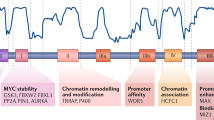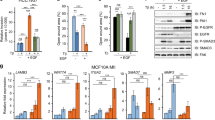Abstract
E-cadherin expression was previously shown to be activated by RB and c-myc specifically in epithelial cells, through interaction with the AP-2 transcription factor. Here we show that only a wild type c-myc gene, coding for the two c-Myc proteins c-Myc2 and c-Myc1, was able to transactivate the E-cadherin promoter, in contrast to c-Myc2 or c-Myc1 alone which strongly repressed E-cadherin in both epithelial cells and fibroblasts. In addition, overexpression of c-myc2 or c-myc1 inhibited c-myc and RB-mediated activation in a dose-dependent manner, suggesting that the ratio of the two c-Myc proteins is essential for transactivation. We also showed by using several mutants of the E-cadherin promoter, that the AP-2 binding sites were the main target of c-myc2- and c-myc1-mediated repression. AP-2-mediated inhibition was cell-type specific, as was the activation. Nevertheless, when high amounts of c-myc2 and c-myc1 were used, a second c-myc-mediated repression was observed, possibly mediated by the Inr sequence of the E-cadherin promoter. However, this repression was independent of cell type. Our results suggest a new way to regulate c-myc transcriptional activity by interfering with the ratio of the two c-myc proteins, which has already been found to be disrupted in vivo in several tumor types.
This is a preview of subscription content, access via your institution
Access options
Subscribe to this journal
Receive 50 print issues and online access
$259.00 per year
only $5.18 per issue
Buy this article
- Purchase on Springer Link
- Instant access to full article PDF
Prices may be subject to local taxes which are calculated during checkout






Similar content being viewed by others
References
Batsché E, Muchardt C, Behrens J, Hurst HC and Crémisi C. . 1998 Mol. Cell. Biol. 18: 3647–3658.
Behrens J, Löwrick O, Klein-Hitpass L and Birchmeier W. . 1991 Proc. Natl. Acad. Sci. USA 88: 11495–11499.
Bernards R, Dessain S and Weinberg R. . 1986 Cell 47: 667–674.
Blackwell TK, Kretzner L, Blackwood EM, Eisenman RN and Weintraub H. . 1990 Science 250: 1149–1151.
Blackwood EM, Gross Lugo T, Kretzner L, King MW, Street AJ, Witte ON and Eisenman RN. . 1994 Mol. Biol. Cell 5: 597–609.
Cole MD. . 1986 Annu. Rev. Genet. 20: 361–384.
Crémisi C. . 1989 Mechanism of B cell neoplasia (ed. Roche) 314–320.
Dosaka-Akita H, Rosenberg R, Minna JD and Birrer MJ. . 1991 Oncogene 6: 371–378.
Gaubatz S, Imhof A, Dosch R, Werner O, Mitchell P, Buettner R and Eilers M. . 1995 EMBO J. 14: 1508–1519.
Hann SR and Eisenman RN. . 1984 Mol. Cell. Biol. 4: 2486–2497.
Hann SR, King MW, Bentley CW, Anderson CW and Eisenman RN. . 1988 Cell 52: 185–195.
Hann SR, Sloan-Brown K and Spotts GD. . 1992 Genes Dev. 6: 1229–1240.
Hann SR. . 1994 Biochimie. 76: 880–886.
Hann SR, Dixit M, Sears RC and Sealy L. . 1994 Genes Dev. 8: 2441–2452.
Hennig G, Löwrick O, Birchmeier W and Behrens J. . 1996 J. Biol. Chem. 271: 595–602.
Henriksson M and Lüscher B. . 1996 Adv. Cancer Res. 68: 109–182.
Imagawa M, Chiu R and Karin M. . 1987 Cell 51: 251–260.
Inghirami G, Grignani F, Sternas L, Lombardi L, Knowles DM and Dalla-Favera R. . 1990 Science 250: 682–686.
Jiang M-S, Tang Q-Q, McLenithan J, Geiman D, Shillinglaw W, Henzel W and Lane D. . 1998 Proc. Natl. Acad. Sci. USA 95: 3467–3471.
Kretzner L, Blackwood EM and Eisenman RN. . 1992 Nature 359: 426–429.
Land H, Chen AC, Morgenstern JP, Parada LF and Weinberg R. . 1986 Mol. Cell. Biol. 6: 1917–1925.
Li L, Nerlov C, Prendergast G, MacGregor D and Ziff EB. . 1994 EMBO J. 13: 4070–4079.
Maheswaran S, Lee H and Sonenshein G. . 1994 Mol. Cell. Biol. 14: 1147–1152.
Martel C, Lallemand D and Crémisi C. . 1995 Oncogene 10: 2195–2205.
Muchardt C, Seeler JS, Nirula A, Gong S and Gaynor R. . 1992 EMBO J. 11: 2573–2581.
Onclercq R, Gilardi P, Lavenu A and Crémisi C. . 1988 J. Virol. 62: 4533–4537.
Onclercq R, Lavenu A and Crémisi C. . 1989 Nucleic Acids Res. 17: 735–753.
Ramsay G, Stanton L, Schwab M and Bishop JM. . 1986 Mol. Cell. Biol. 6: 4450–4457.
Roy A, Carruthers C, Gutjahr T and Roeder RG. . 1993 Nature 365: 359–361.
Shrivastava A, Saleque S, Kalpana GV, Artandi S, Goff SP and Calame K. . 1993 Science 262: 24796–24804.
Spotts GD and Hann SR. . 1990 Mol. Cell. Biol. 10: 3952–3964.
Templeton DJ, Park SH, Lanier L and Weinberg RA. . 1991 Proc. Natl. Acad. Sci. USA 88: 3033–3037.
Tronche F, Rollier A, Bach I, Weiss MC and Yaniv M. . 1989 Mol. Cell. Biol. 9: 4759–4766.
Versteeg R, Noordermeer A, Krüse-Wolters M, Ruiter DJ and Schrier PI. . 1988 EMBO J. 7: 1023–1029.
Williams T, Admon A, Lüscher B and Tjian R. . 1988 Genes Dev. 2: 1557–1569.
Williams T and Tjian R. . 1991 Science 251: 1067–1071.
Yang B-S, Beddes TJ, Pogulis RJ, De Crombrugghe B and Freytag SO. . 1991 Mol. Cell. Biol. 11: 2291–2295.
Acknowledgements
We are very grateful to S Hann for the CMV c-myc1, CMV c-myc2 and (EMS)4CAT constructs, to B Eisenman and to E Blackwood for c-myc mut3 and mut15, to E Ziff and F Tronche for the C/EBPα and Albumin promoters. We thank F Besançon for critical reading of the manuscript. This work was supported by grants from Association pour la Recherche sur le Cancer (no. 6256), the Fondation pour la Recherche Médicale and the GEFLUC. E Batsché was supported by predoctoral fellowships from La Ligue contre le Cancer and from La Fondation pour la Recherche Médicale.
Author information
Authors and Affiliations
Rights and permissions
About this article
Cite this article
Batsché, E., Crémisi, C. Opposite transcriptional activity between the wild type c-myc gene coding for c-Myc1 and c-Myc2 proteins and c-Myc1 and c-Myc2 separately. Oncogene 18, 5662–5671 (1999). https://doi.org/10.1038/sj.onc.1202927
Received:
Revised:
Accepted:
Published:
Issue Date:
DOI: https://doi.org/10.1038/sj.onc.1202927
Keywords
This article is cited by
-
Disregulation of E-cadherin in transgenic mouse models of liver cancer
Laboratory Investigation (2004)
-
Neural crest specification: migrating into genomics
Nature Reviews Neuroscience (2003)



